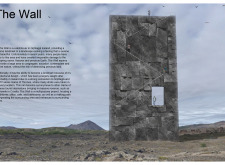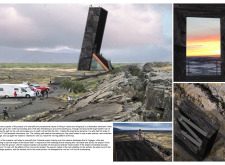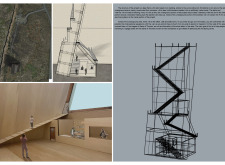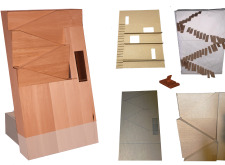5 key facts about this project
The Wall in Grjótagjá, Iceland, stands as a watchtower designed to fit naturally within a landscape that features geothermal hot springs and deep fissures. Its purpose is to offer a gathering place for visitors, allowing them to take in the unique scenery while also fostering a sense of community and reflection. The design aims to enhance the experience of being in such a remarkable environment while addressing the need for sustainable tourism.
Structural Design and Integration
The slanted wall of the structure provides both a functional and aesthetic role. It leans over the vast landscape of Vogagja, creating a visual connection to the geological formations nearby. Visitors encounter a defined pathway that guides them up and around the wall. This journey encourages them to engage physically with the architecture and appreciate the surrounding beauty.
Materiality and Construction
Construction utilizes a strong steel frame to ensure the stability of the structure. The outer layer is covered in dark basalt rock, a material that matches the local geography and allows the building to blend in with its surroundings. In addition, concrete is used for the underground spaces, offering durability, while the roof features artificially rusted metal, contributing to a cohesive overall design.
Visitor Experience and Functionality
Inside the underground area, visitors find a well-organized space that enhances their interaction with the wall. As they descend, they are surrounded by the structure, enriching their connection to both the architecture and the environment. Essential services, such as an office and café, are thoughtfully integrated, ensuring that practical needs are met along with visitor enjoyment.
Environmental Considerations
The design pays careful attention to environmental factors, especially wind. The shape of the wall and careful placement of openings help to manage wind pressure effectively. This consideration allows for comfort and stability, ensuring that the structure remains functional and inviting.
The elements of this design come together to create a unique experience. The pathway encourages visitors to touch the rock surfaces, fostering a deeper connection between the built environment and the natural landscape.






















































